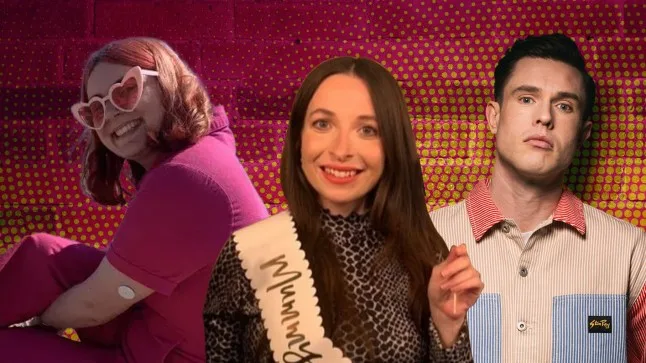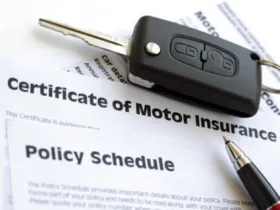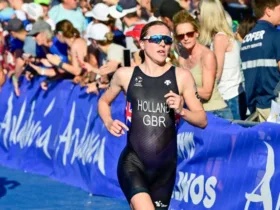
Almost 10 years ago, I came down with a seemingly mystery illness. At 17, I had a clean bill of health – and had barely set foot in the doctors’ surgery my entire childhood.
But within a matter of weeks, something had changed. I’d gone from being a healthy teenager to one who could barely muster enough energy to get through the day.
Struggling with extreme fatigue, insatiable thirst and aches and pains, every day after I got home from sixth form, I’d come home and sleep until dinner. I blamed the intensity of studying for my A Levels, but I knew something was wrong.
-Advertisement-.
I hadn’t really noticed anything out of the ordinary (bar the tiredness) until someone – a friend – commented on my appearance. They told me I looked like I’d lost weight and asked ‘what diet I was on.’ Then, everything clicked into place.

Finally, after almost six months of symptoms that seemed to worsen by the day, I was diagnosed with type 1 diabetes.
The comments about my weight (which, concerningly, I’d taken on in an empowering way, overjoyed to be told that, as a permanent size 14, I looked ‘skinny), figured too, as I was between two and three stone lighter than my usual weight.
I referred to my symptoms as a ‘mystery illness,’ because for months, I couldn’t seem to find an answer that stuck. I’d been to the doctors about my insatiable thirst a few months prior, only to be incorrectly diagnosed with oral thrush and sent away with some antifungal medication.

But it was my mum who realised it was type 1 diabetes I was likely suffering with, as she recalled a school trip where a friend of hers was diagnosed after experiencing similar symptoms.
And so, she marched me into the doctor’s office and demanded that they test my blood sugar.
The alarming figure on the screen told them everything they needed to know, and they sent me straight to the hospital, where the specialist told me that if I came in any later, I might not have survived.
That first period after diagnosis might’ve felt alienating, as I was grappling with learning how to navigate an entirely new condition (and one that seemed to take all of my energy and, most nights, my sleep), but I certainly wasn’t alone.
Living with type 1 diabetes at university
Ryder Rickhards was diagnosed with type 1 nine years ago when he was 10 years old.
But he wasn’t the first in his family, as his brother was diagnosed about a decade before him, so they were well-acquainted with the warning signs.
‘We knew pretty quickly what it was, as I did a blood test on my brother’s machine and we all watched in suspense to see the reading,’ Ryder, now 19 and living in North London, tells Metro.
‘I got a lot of time off school, and also my friends were really nice about it and made me a card. In truth, I felt kind of special.
‘I was also just relieved to be free from the discomfort I’d been living in and finally have some insulin.’
These days, Ryder’s control isn’t ‘the best’ as he often ‘forgets’ to administer his insulin and so has to miss a considerable amount of university and rugby training – which he describes as ‘the worst part’ of living with type 1.

However, he doesn’t feel ‘hard done by’ as he sees his diabetes as something he ‘can’t change’ – which, since there sadly isn’t a cure yet, rings true.
‘I also think living with diabetes has made me mentally stronger, more resilient and organised. It keeps me on my toes if anything, and reminds me that nothing in life is free, and I must always be prepared,’ he adds.
Sadly, Ryder often receives ignorant comments from strangers who, learning about his condition, are often shocked because he ‘isn’t fat.’
‘I get a lot of questions about it, which used to get on my nerves because back in school I was embarrassed to inject, or even do a blood test in front of people. I think I just didn’t want to be different,’ he notes.
‘Nowadays though, I’m happy to answer people’s questions about it and feel I can be a lot more open.’
Notably, these questions come from a misunderstanding about the differences between type 1 and other forms of diabetes – something he wished the public knew more about.
‘I’ve seen countless articles and books just refer to it as “diabetes”‘, he adds. ‘It would be nice if people had this understanding, and it would save a lot of explaining.’
Living with type 1 diabetes in the public eye
When it comes to type 1 diabetes, visibility means everything. And countless celebrities diagnosed with the condition have been doing just that, from model Lila Moss wearing her insulin pump on the catwalk to Este Haim doing the same on the world-famous Pyramid Stage at Glastonbury.
Comedian Ed Gamble was diagnosed in 1999 at the age of 13. But he insists the year wasn’t a total write off, insisting that it ‘remains the best year for music ever.’

‘I am one of the very lucky ones as my mum was a nurse for many years and noticed symptoms before they became dangerous or caused a massive event,’ he tells Metro.
‘She took me to the GP and I was diagnosed quite quickly, before I even noticed there was a problem.
‘I know a lot of people have a much more traumatic diagnosis story often involving emergency hospital visits, so I feel quite relieved that my Mum spotted the signs like increased thirst and toilet trips.’
What is type 1 diabetes?
As per the NHS website, type 1 diabetes ‘causes the level of glucose (sugar) in your blood to become too high. It happens when your body cannot produce a hormone called insulin, which controls blood glucose.’
As a result, those living with type 1 diabetes need to constantly monitor their blood glucose levels either through a manual finger prick test or via a continuous glucose monitor (CGM), which is worn on the arm and tests glucose through the tissue.
They also need to give themselves insulin either by injecting through a needle, or by wearing an insulin pump.
Like the CGM, the insulin pump is connected to the body like a cannula, and continuously drip feeds insulin to regulate glucose levels. It’s also necessary to administer insulin before eating by counting the carbohydrates, which are then converted into units using a formula specific to the individual.
In the UK, less than one in 10 people in the UK living with some form of diabetes has type 1 diabetes. Approximately 90% of diabetes diagnoses are of type 2 diabetes.
Crucially, type 1 diabetes is not related to diet and lifestyle choices. As the Diabetes UK website outlines, the exact causes of type 1 diabetes are not known, and there currently isn’t a cure.
But it took a while for Ed to take it all in – and he says it took him ‘years’ to understand his new reality.
‘Everything was explained properly of course, but you can’t really predict how the young teenage brain will react. It’s such a whirlwind of information and it takes a while to get used to it all. Type 1 is a life of surprises, even now, and it’s just all about how you react and learn from what it can do.’
Fast forward to 2024, and Ed injects himself with insulin and wears a Dexcom (a type of continuous glucose monitor), technology which he says has ‘revolutionised’ his life.
‘The thing that’s helped me most is seeing whether my glucose levels are trending up or down and how quickly. It’s completely changed the way I think about my control, given me way more insight and made my life a lot easier,’ Ed adds, noting that since he’s on stage a lot for his job, it helps him to manage the anxiety surrounding his blood glucose levels.
‘I’m much better at dealing with the bad days now – there are more and more tools to help like Dexcom, and I think things will just keep on getting more advanced and help us manage our condition.’
Mothering a child with type 1 diabetes
Though 47-year-old Tracy Vinnicombe doesn’t live with type 1 diabetes herself, her 13-year-old son George does.
When George was six months old, Tracy noticed that he’d rapidly been losing weight, and had been experiencing laboured breathing and projectile vomiting. After she took him to the doctors and expressed her concern, they were taken to A&E in an ambulance.
On the way to Evelina Children’s Hospital, his veins collapsed but luckily professionals were able to retrieve them and place him on an IV to receive fluids and insulin, something he desperately needed after being down with a mysterious illness for two months.
By the time he was treated by doctors, Tracy was told that her son was dangerously ill – so much so that he risked not making it.
‘It was the worst time of our lives. We thought he had a virus or chest infection, but we were told four hours later that our son was going to die,’ Tracy, who lives in Surrey, tells Metro.
As such, they didn’t feel relieved to receive a diagnosis for him – only guilt that they ‘hadn’t spotted the signs earlier.’
Luckily, doctors were able to treat George and now, he’s 13 years old. But that doesn’t mean that life has got much easier for the family, as Tracy wouldn’t wish parenting a child with type 1 diabetes ‘on her worst enemy.’
‘You’re a carer primarily, keeping your child alive is your main priority. All the medical interventions of cannulas, finger pricks and sensors cause absolute distress and pain of which is necessary to keep him alive,’ Tracy shares.

‘We’ve had to hold him down physically for cannula changes hundreds of times, [which was] awful.’
Tracy has another child, Ava, who doesn’t have type 1 diabetes, and she’s noticed that her conversations with George are markedly different, often concerned with blood sugar levels, insulin injections, and general management of the condition to keep him safe.
Naturally, because George lives with type 1, he needs extra support at school – and accessing that hasn’t been without its difficulties over the years.
Tracy has had to fight to get funding for George’s carers, as well as train up and shadow staff herself to ensure he’s safe at school. She’s even had to seek legal action.
Now at secondary school, Tracy continues to worry about George monitors his diabetes at school. He keeps his ‘hypo bag’ with, which he carries times. It contains, hypo supplies like a glucose drink and apple juice, and his finger prick kit to test his blood sugar.
Tracy also wishes there was more education to help people understand the difference between type 1 and type 2 diabetes. ‘They are not the same,’ she says.
What is type 2 diabetes?
As per the Diabetes UK website definition, type 2 diabetes involves ‘high blood sugar levels due to your body not making enough of a hormone called insulin, or the insulin it makes not working properly.’
Importantly, type 1 and type 2 diabetes are very different – and, despite societal misconceptions, type 2 isn’t always preventable, or caused by diet and lifestyle.
Many cases are hereditary, as according to Diabetes Education Online, between 80 and 90% of type 2 diabetics also have a relative with the condition, and between 10 and 15% of children with a type 2 diabetic parent will also develop the condition.
Getting a mid-pregnancy diagnosis of gestational diabetes
When Kat Romero, 36, was 28 weeks pregnant with her son in 2021, she started to experience blurred vision and increased thirst.
Having read up about gestational diabetes (high blood sugar that develops during pregnancy and typically disappears post-birth), she requested a test from her doctor.
As part of the assessment, she was given a sugary drink to see how she would react – and instantly felt very faint and dizzy.
‘The nurses seemed concerned I had it before the results even came in,’ Kat, who lives in London, tells Metro.
‘I waited a few days and then got a phone call to say I had it. I was very upset because it meant I had to change my whole diet and my pregnancy become more heavily monitored.’

From then onwards, she had to test her blood sugar four times a day, as well as strip out foods that were high in carbs and processed sugar.
‘My whole diet had to change, and I had to be considered with portion control at every meal,’ Kat adds.
‘Not exactly what you want when you’re pregnant and have cravings. When I got into the final weeks of my pregnancy, my blood sugar levels spiked no matter what I ate and I was losing weight, so I was put on Metformin to control it.’
When Kat told her friends and family about her diagnosis, many of them were surprised as she wasn’t particularly high risk (the likelihood of developing it increases if the mother is over 40 or has a BMI over 30).
However, almost everyone was understanding – and she found that she had to educate herself on all forms of diabetes, too.
‘Some people thought I’d given it to myself through a poor or high-sugar diet. A few people asked me if I’d overeaten or indulged my sweet tooth a bit too much,’ Kat adds.
‘But in my case, it was just something that happened. My midwives told me I hadn’t done anything to cause it.’

When she stayed in hospital post-birth though, she wasn’t offered food in line with her diabetes diet.
‘I either didn’t eat or my partner would have to head to the hospital café or shop to buy me food that was low in sugar and carbs,’ she notes.
‘It was upsetting as I assumed there’d be an option for people with my condition.’
After the birth, Kat’s diabetes disappeared, as happens with most cases. She did have to have blood tests following the birth to check her levels were back to normal, and as she notes, ‘thankfully they were.’
Now, she has an annual blood test – and acknowledges that she always ‘knew there was a light at the end of the tunnel,’ but that her diagnosis ‘added an extra layer of stress’ she didn’t ‘need.’
Do you have a story to share?
Get in touch by emailing MetroLifestyleTeam@Metro.co.uk.










